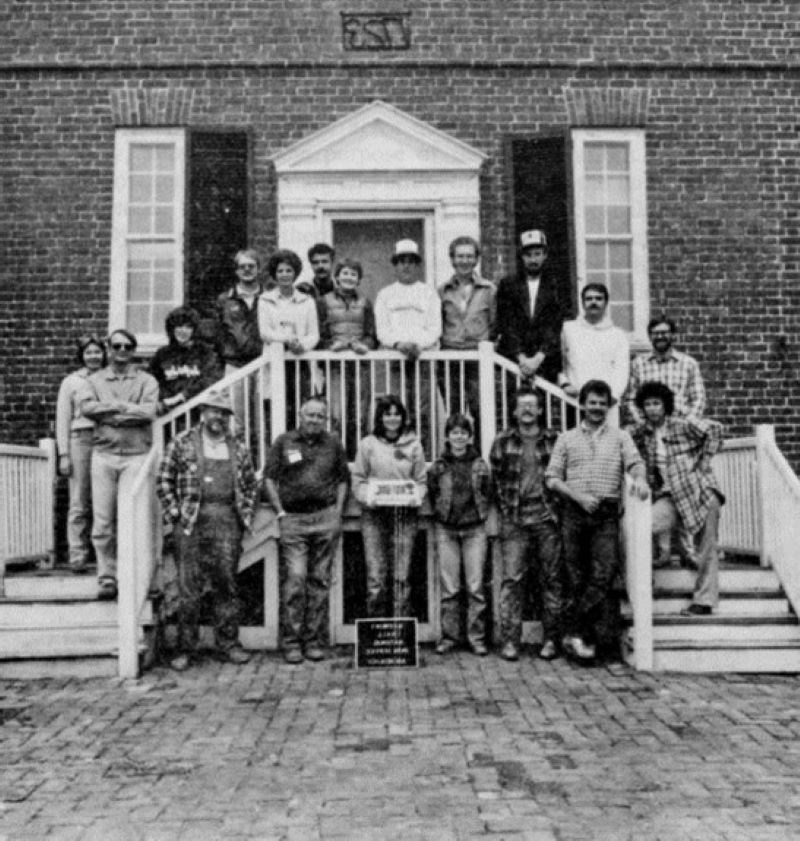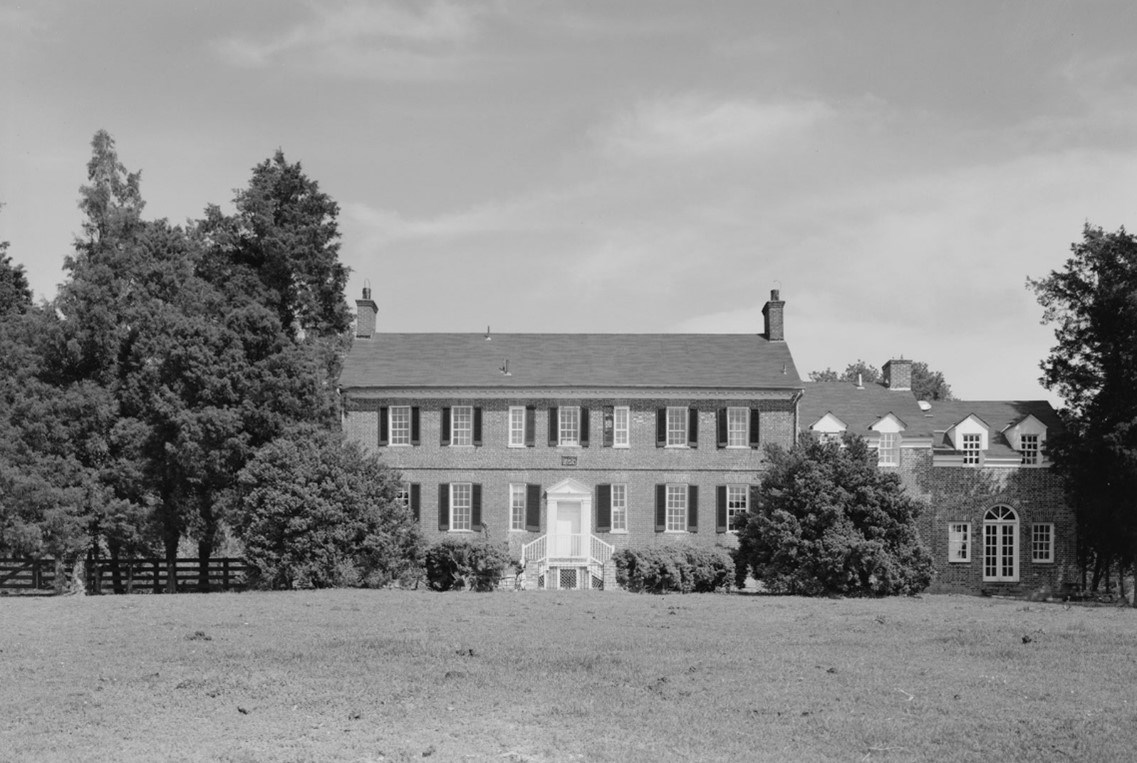Last updated: November 5, 2024
Article
The Confounding Mystery of the Red-Brick Manor at Harmony Hall
Broad Creek straddled two worlds in the 1600s: that of the Piscataway people, for whom the land likely constituted important hunting and fishing grounds, and that of the European colonists who settled it starting in 1634. While the Broad Creek community, known also as the town of Aire/Ayres, prospered as an Atlantic port city before collapsing due to the American Revolutionary War, one estate—and Harmony Hall, the stately red-brick Georgian manor house that renamed it—weathered it all.
Humphrey Haggett patented the original 500-acre tract named Battersea in 1662, though ownership quickly passed in 1668 to Richard Fowke, who married Haggett’s widow. Fowke split the property and sold the portion that would become Harmony Hall to Philip Mason. The property was then subdivided and transferred to a series of different owners, including Thomas Lewis, William Tyler, and the Magruder-Lyles family. Here is where the historical record grows murky, and here is where archeology casts a light, only to raise more questions than answers.
Humphrey Haggett patented the original 500-acre tract named Battersea in 1662, though ownership quickly passed in 1668 to Richard Fowke, who married Haggett’s widow. Fowke split the property and sold the portion that would become Harmony Hall to Philip Mason. The property was then subdivided and transferred to a series of different owners, including Thomas Lewis, William Tyler, and the Magruder-Lyles family. Here is where the historical record grows murky, and here is where archeology casts a light, only to raise more questions than answers.

A House with Many Lives
Beginning in the fall of 1985 and continuing intermittently until the summer of 1987, archeologists and over 75 volunteers with the National Park Service Regional Archeology Program excavated 49 five-by-five-foot square units at Harmony Hall. Originally intended to assess Section 106 compliance, the project and an extensive follow-up survey in 2014 uncovered an unexpected wealth of features—from trash pits from the late 1700s to a large scatter of 19th through 20th-century outbuilding remains—that both corroborate and contradict the house’s timeline.No improvements to the land seem to have been made before Thomas Lewis performed at least some agricultural activity on-site. Lewis held the property from 1692 to 1696 or 1697. A historical inventory of his estate clearly depicts a comfortable household, and the array of animal bones unearthed at the site align with the animals listed in the same document. Lewis is also responsible for the first residence at Battersea, which was first occupied around 1690.
Several feet east of the Harmony Hall manor house yielded a post hole and a borrow pit associated with an earthfast house, a type of house in which the structure does not rest on a foundation but is instead laid directly on the ground surface or set into the ground on posts. Six distinct strata within the borrow pit could be tightly dated to the late 1600s to early 1700s. The high amount of late 1600s to early 1700s domestic debris, including seven sherds of Delftware and Buckley redware and four tobacco pipe stems, more tightly links the feature to the earthfast dwelling. The pit itself, which also contained charred wooden members, charcoal, and ash, was likely used to mine for clay to construct and periodically repair the earthfast structure’s chimney. For a modest building on a western frontier farm, the impressive collection of consumer goods at Battersea reflects the wider Broad Creek community’s integration into maritime trade.

The Battersea property belonged to absentee owners in the mid-1700s. A handful of colonial artifacts found in the field beyond Harmony Hall’s front yard may represent a short-lived tenant or enslaved occupation dating to the mid-1700s. No one appears to have lived at Battersea from Tyler’s death until merchant and planter Enoch Magruder purchased the tract around 1761. Magruder designated Battersea his primary residence and is likely the builder of the Harmony Hall mansion, which served as a showpiece mansion. Archeological attempts to locate a builder’s trench for Harmony Hall’s foundation, first in the northeast corner and then in the southwest corner, were inconclusive. The construction of a twentieth-century French drain around the house likely destroyed any builder’s trench that may have existed.
Although two excavated refuse pits yielded ceramic vessels with a mean date of 1729, the absence of mid-1700s ceramics could suggest a post-1769 construction timeframe. Alternatively, the absence may also be a consequence of the property being leased to tenants, which could support Harmony Hall existing before Tyler’s death. Thus, the mystery of Harmony Hall’s construction remains unsolved.
Shadows Over a Community
The Magruder-Lyles family continued to own the property and intermittently lived there while also renting it out. William Edelen purchased the land in 1850 and sold it in 1867 to another owner. The story goes that sometime in those intervening years, two newlywed couples enjoyed the manor house so much they bestowed it with the permanent moniker “Harmony Hall.” Eventually, German immigrant Robert Stein purchased the Broad Creek properties in 1892 to establish a new community with his relatives.By the 1920s, the tobacco industry had collapsed. Broad Creek, once a commercial town of farmers and markets buoyed by maritime trade and the labor of enslaved African Americans in their homes and fields, reverted to a rural atmosphere. Charles Wallace Collins, however, envisioned the area differently. A pro-segregation Washington insider, Collins reimagined the setting as a relic removed from modern pressures. In the 1930s and 1940s, Collins and his wife “restored” Harmony Hall to resemble an antebellum Old South plantation. Their work damaged and destroyed traces of the site’s past with little documentation of what had been erased.

By re-exposing the red-brick house at the center of it all, the initial archeology project at Harmony Hall lays the foundation for detailing the experiences of the entire town, its inhabitants, and its unrecognized laborers. Although nothing is currently known about where the enslaved African Americans on the property might have once lived, there is potential for rediscovering them. Ethnographic research with the descendant communities and additional archeological investigations at Harmony Hall are two tools that could shed light on their story. Perhaps future research will enable us to create a richer understanding of all people who made history at Harmony Hall.
Resources
Archeology at Harmony Hall: Exploring the Late Seventeenth-Century Frontier of Maryland. Prepared by The Louis Berger Group, Inc. for the National Park Service, 1993.Archeological Overview and Assessment of Harmony Hall Maryland. National Park Service, 2015.
Cultural Landscapes Inventory Harmony Hall. National Park Service, 2018.
Reed, Charles V. “History of Harmony Hall.” University of Maryland, College Park, commissioned by National Park Service.
